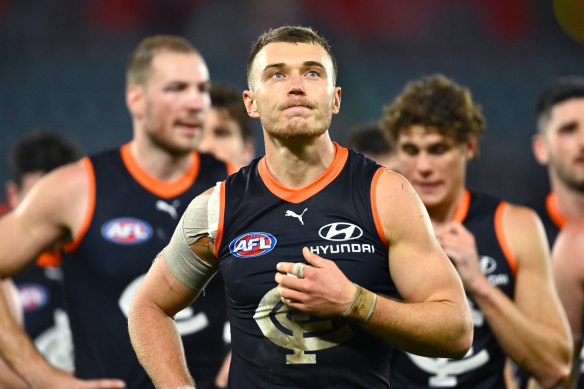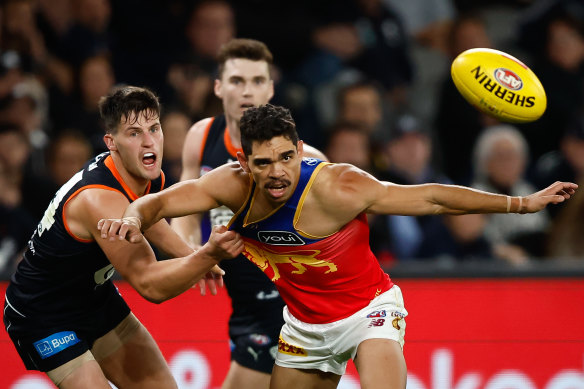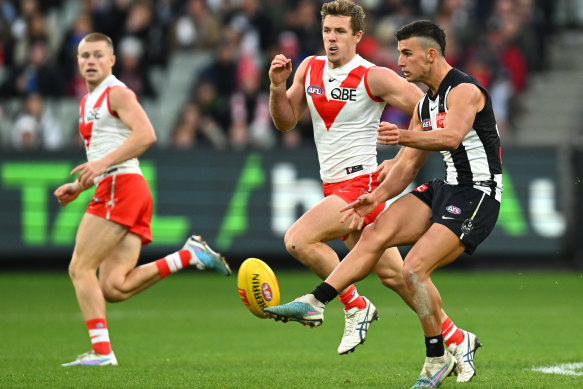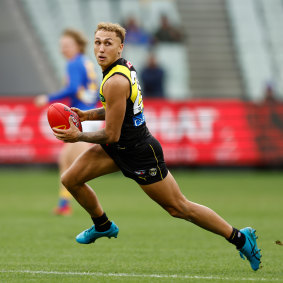Why Carlton have the blues
The theory has been you stop Paddy Cripps and you stop Carlton. And it’s true, to an extent.
The other part to the newer theory is that, presently, you can rely on Carlton to do your job for you. Carlton helps stop Carlton.
This is not to diminish Brisbane’s outstanding, intelligent effort and intense pressure on Friday night, but Carlton are the most self-destructive of the top eight teams. Their ball use is just dreadful for a side with pretensions to finals.

Paddy Cripps looks dejected after the loss against the Brisbane Lions.Credit: Getty Images
Carlton gave up 85 points from turnovers on Friday night, their worst turnover performance since 2021 and the fourth-worst of any side this season. Bearing in mind some of the poor teams at the bottom of the ladder that is quite some feat. They now concede 46 points a game from turnovers on average.
In the last month, Carlton have given up 62 points against Adelaide, 52 against St Kilda, were ahead against West Coast in outscoring them by 16 points from this scoring source, and then they had the 85 points they gave up against Brisbane.
Clearly in those last four games lowly West Coast distorts the figures. If you take that game out (and therefore look at them against three other teams in the top eight) then Carlton have been just awful and bottom three with North and West Coast for points conceded from turnover. Even Hawthorn is above them
Bear in mind they were not always this bad, even this year. In the first month, even against other good teams, they were the opposite of what they are now. They were very good at forcing the opposition into turning the ball over and in that first bracket of four games they outscored their opposition from scores created by turnovers. But in the last month they have fallen to pieces.
What Friday’s game revealed is that Brisbane did their homework on the Blues. Yes, they went to work on Cripps and the Carlton captain consequently had it only 17 times, but they also went in with a plan knowing that Carlton have been vulnerable to giving the ball back and being scored against.

Charlie Cameron was on song for the Lions against Carlton.Credit: AFL Photos
The Lions looked more frenetic in team defence than they have been all year. They hunted the ball and the man with it. They knew the numbers pointed to Carlton turning the ball over under pressure, and they ratcheted up the way they hunted the man with the ball. They closed down space, then they closed down the exit options and forced the Carlton player into panicked error. Their plan worked.
They also played a team tagging role on Adam Saad that was just as consequential as the job they did on Cripps.
All Lions forwards were alert to never leave Saad unchecked whenever Carlton won the ball in defence. They were at his shoulder at all times and refused to allow him the easy handball receive, mindful that he is their best ball user and most damaging runner. He still had it 17 times, but he was nowhere near as creative and damaging as he normally is.
Carlton are no longer playing like a top-eight team. They are playing like a side uncertain of themselves, still carrying the scars of last year’s end-of-season collapse and the knowledge there is a frailty to them.
The Geelong victory in round two now looks like an outlier to the season and is perhaps given better context from the way Geelong have grown into the season from such a poor start.
The focus on Daicos
Where Brisbane’s plan for Saad had an intelligent, organised method about it, Sydney’s plan for Collingwood’s defensive running architect Nick Daicos was more blunt instrument: Whack him.
Other teams have tried different options with Daicos to little effect, so Sydney applied the more basic physical approach to physically work him over. It was a full-team approach. The tactic worked primarily to excite the Magpies into defending their teammate, but appeared to have minimal impact in dulling the young talent.

Nick Daicos came in for plenty of attention against the Swans.Credit: Getty Images
What was partially more effective was the Swans’ broader tactic on how to deal with Collingwood’s game, rather than their young player. They played a slower possession game, chipping the ball – 132 marks to 72 – and sucking the pace out of the game. The Swans had control of the ball everywhere but forward. Ultimately, the tactic didn’t work because, for all of their patient industry, they couldn’t score and still came up short.
Bolton shows his claws
West Coast are one of the trio of false-dawn teams of the AFL. Forget getting too excited about beating West Coast, North Melbourne or Hawthorn, the results are basically pre-ordained and performances mean little.

Shai Bolton on the run for the Tigers.Credit: AFL Photos
Just look at Carlton last week to this.
So Richmond won’t be frothing about beating the Eagles. They will though be encouraged by Shai Bolton having his best game of the year.
Geelong, likewise, will be pleased to be back winning again but victories over Sydney when Callum Mills had to play full-back and Essendon, who had no tall backs, will have left them cautiously pleased. Beating a vastly improved Adelaide, at home, was the best of those wins.
Now the hamstring injury to Paddy Dangerfield, coupled with the toe injury to Cam Guthrie, has ushered in the moment for Geelong to look at their next-generation midfield. Max Holmes was excellent moving on the ball from a wing on Saturday and Tanner Bruhn was brought into the club for just this type of role.
They face Richmond on Friday night, and it is a Tigers team that was run into better form by the Eagles. Richmond always look vastly different with Dion Prestia in the team and, yes, Bolton had his best game of the year, but Jacob Hopper was the one. He has been good after a slow start this year and was very good on Saturday. This is the moment Hopper can stamp himself as the Tigers’ midfield leader.
Goal-line madness
Brody Mihocek might have shepherded the ball through for a goal on the goal line in the last minutes. But that would have been easy.
Instead, Mihocek’s soccer volley out of the air was gloriously inventive. Look, it’s not better than Will Ashcroft from last week, but it was very clever.
Meanwhile, Jack Gunston, who has been a very good free-agent pick-up for the Lions, had a moment on the goal line the like of which he probably has never had. You couldn’t call it a missed shot because he never actually kicked the ball. Gunston missed his foot.
In the goal square with players descending on him, Gunston was only a metre out when he tried to poke the kick through and kicked only fresh air. It might be the worst – or at least funny – miss of his career.
Keep up to date with the best AFL coverage in the country. Sign up for the Real Footy newsletter.